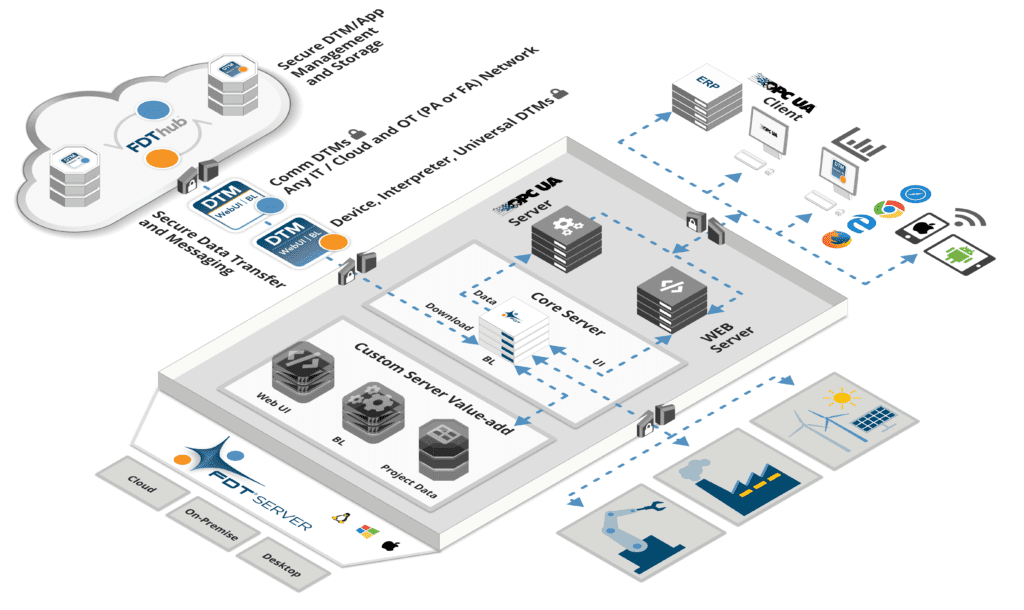
FDT Group™, an independent, international, not-for-profit industry association supporting the evolution of FDT® technology, today announced the release of its platform-independent FDT 3.0 – FDT IIoT Server™ (FITS™) standard built to empower digital transformational benefits for the automation supplier and end user communities in the process, hybrid and discrete markets.
Suppliers of industrial automation systems and devices want to seize emerging opportunities for Industrial Internet of Things (IIoT) solutions. They’re seeking to enhance their product offerings with standards-based, platform-independent, information-driven business models for the new era of automation.
The new FDT 3.0 standard will accelerate the evolutionary journey into the Fourth Industrial Revolution by enabling an ecosystem of FDT-based solutions to meet demands for IIoT and Industrie 4.0 applications. In addition to the new FDT 3.0 standard that fully describes the FITS platform, FDT Group released the FDT 3.0 Developer Toolkits to help the vendor community jump start development efforts with a modernized Integrated Development Environment (IDE) to easily create and customize next-generation, cross-platform FDT 3.0 solutions.
“The new FITS architecture is a powerhouse that is the enabler for scalable, remote access business solutions and services that are needed now to meet changing market demands,” said Glenn Schulz, managing director, FDT Group. “By delivering the FDT FITS specification and platform independent toolkits simultaneously, we are enabling the immediate deployment of this new technology. To meet the digital transformational needs for next generation smart plants and factories, the FITS architecture is scalable from skid to cloud, sits at a peer level with the control system and integrates all industrial control networks. This approach provides secure, remote access to live device and network data across the enterprise without PLC/DCS host intervention. While the FITS standard is fully browser based, we have also built in a full OPC UA server to provide an industry standard conduit for IT and OT information integration.”
FDT Group, founded by a group of leading automation manufacturers during the Third Industrial Revolution, developed FDT technology as an open, integration standards-based solution to fix interoperability issues for control system and device end users. The standard quickly gained global, industry-wide acceptance and today is widely deployed as the de-facto integration standard providing end users with the freedom to choose systems/devices that best fit their application and seamlessly connect and communicate independent of the chosen vendor or network.
Over the years, the FDT standard has evolved from a single-user, desktop environment (FDT 1.x) to a distributed, multi-user client/server approach (FDT 2.x) with OPC Unified Architecture (OPC UA) compatibility for enterprise-wide integration and asset management. The newly launched FDT 3.0 standard builds off its solid foundational base and brings enhancements empowering an FDT Server embedded with OPC UA and Web Servers. The new Server delivers universal device integration and a data-centric platform to mobilize the industrial workforce with modern and diverse deployment options, including cloud, enterprise, edge, on premise, and single-user desktop environments.
In 2016, FDT’s leadership team approved the transformation journey into the Fourth Industrial Revolution to empower an ecosystem of FDT IIoT-ready solutions. FDT 3.0 was developed based off industry-driven feedback and delivered by a collaborative team of experts in the industry. Schulz stated, “Aimed at transforming manufacturing practices, FITS enables a cloud-based asset management solution with built-in security, scalable deployment, IT/OT integration, universal and backwards compatibility, and a single FDThub repository for FDT Device Type Managers.”
The FDT IIoT ecosystem consists of FDT Server, FDT Desktop and FDT DTM components, which are fully deployable out of the box using the IDE tools, known as Common Components. Now, system and device suppliers can take a well-established standard they are familiar with and easily create and customize standards-based, data-centric, cross-platform FDT IIoT solutions—expanding their portfolio offerings to meet requirements for next-generation industrial control applications. Each solution auto-enables OPC UA integration and allows the development team to focus on value-added features that differentiate their products, including WebUI and App support. FDT Desktop applications are fully backwards compatible supporting the existing install base.
FDT 3.0 specification license agreements and developer toolkits are now available on the FDT website (www.fdtgroup.org). In addition to the FDT 3.0 standard and developer toolkits, an IO-Link Interpreter DTM is under development along with FDT communication annexes for HART™, Profibus™, IO-Link™ and CIP networks slated for release in the latter half of 2020.
FDT 3.0 (FITS) Architecture Diagram
